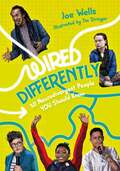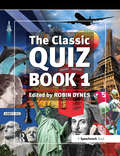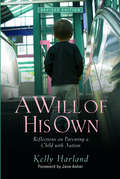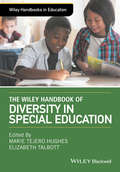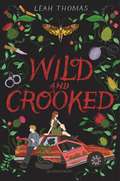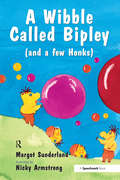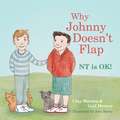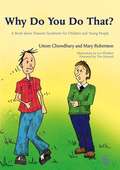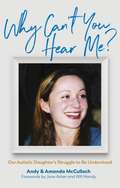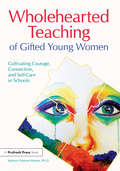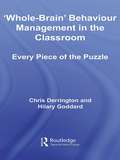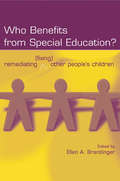- Table View
- List View
Wired Differently – 30 Neurodivergent People You Should Know
by Joe WellsThis collection of illustrated portraits celebrates the lives of influential neurodivergent figures who have achieved amazing things in recent times.Showcasing these 30 incredible people, the extraordinary stories in this book show that the things they've achieved, created and inspired they did not despite being different but because they are different. From politicians, activists and journalists to YouTubers, DJs and poets, this book highlights a wide range of exciting career paths for neurodivergent readers.
Wired Differently – 30 Neurodivergent People You Should Know
by Joe WellsThis collection of illustrated portraits celebrates the lives of influential neurodivergent figures who have achieved amazing things in recent times.Showcasing these 30 incredible people, the extraordinary stories in this book show that the things they've achieved, created and inspired they did not despite being different but because they are different. From politicians, activists and journalists to YouTubers, DJs and poets, this book highlights a wide range of exciting career paths for neurodivergent readers.
Winston Wallaby Can’t Stop Bouncing: What to do about hyperactivity in children including those with ADHD, SPD and ASD (PDF)
by Haitham Al-Ghani Joy Beaney Kay Al-GhaniWinston Wallaby, like most Wallabies, loves to bounce. However, Winston can't seem to ever sit still and when he starts school he needs help to concentrate... Luckily his teacher Mrs Calm shows Winston how to settle down and focus his mind in class, and he learns new ways to help him with touch, feel, attention and awareness. This fun, illustrated storybook will help children aged 5-10 with Attention Deficit Hyperactivity Disorder (ADHD), Sensory Processing Disorder (SPD) and Autism Spectrum Disorder (ASD) recognise their sensory needs and develop tools to support them. A helpful introduction for parents and carers explains hyperactivity and how it can affect a child's perception of the world, and the appendices at the back provide useful strategies to be adopted at school and at home.
Winslow Quiz Book: A Speechmark Social Activity Manual for Groups Book 1
by Robin DynesThis completely revised edition of Winslow's bestselling Quiz Book contains more than 2,000 questions categorised into 40 stimulating subjects. It is aimed at adolescents and adults alike and features questions that are all realistically within the scope of the average person. Designed for those who use quizzes as a group activity, the questions are grouped into three ability levels with a layout that enables the organiser to rapidly locate the required topic. Its topics cover areas such as cookery, animals, sport, home, spellings, history and general knowledge.
A Will of His Own: Reflections on Parenting a Child with Autism - Revised Edition (PDF)
by Jane Asher Kelly HarlandKelly Harland's stories explore her son's life to the age of 14, and the new and unexpected universe she and her husband - both professional musicians - must learn to navigate with him. Will's fears, anxieties, and obsessions can dominate daily life, making a trip to the grocery store seem like a walk across a minefield. But amidst these unpredictable 'flip-outs' and 'freak-outs,' there are moments of wonder. When Will finally learns the give and take of conversation, or dreams about his future, it rekindles his mother's belief that anything is possible.
A Will of His Own: Reflections on Parenting a Child with Autism - Revised Edition
by Kelly Harland Jane AsherKelly Harland's stories explore her son's life to the age of 14, and the new and unexpected universe she and her husband - both professional musicians - must learn to navigate with him. Will's fears, anxieties, and obsessions can dominate daily life, making a trip to the grocery store seem like a walk across a minefield. But amidst these unpredictable 'flip-outs' and 'freak-outs,' there are moments of wonder. When Will finally learns the give and take of conversation, or dreams about his future, it rekindles his mother's belief that anything is possible.
The Wiley Handbook of Diversity in Special Education (Wiley Handbooks in Education)
by Marie Tejero Hughes Elizabeth TalbottThe Wiley Handbook of Diversity in Special Education is a state-of-the-art reference showcasing cutting-edge special education research with a focus on children and youth with disabilities from diverse cultural, ethnic, linguistic, and economic backgrounds. Cutting-edge special education research focusing on children and youth with disabilities from diverse cultural, ethnic, linguistic, and economic backgrounds An authoritative contribution to the field, this work charts a new path to effective interventions and sets an agenda for future research Addresses disabilities from an international perspective
The Wiley Handbook of Diversity in Special Education (Wiley Handbooks in Education)
by Marie Tejero Hughes Elizabeth TalbottThe Wiley Handbook of Diversity in Special Education is a state-of-the-art reference showcasing cutting-edge special education research with a focus on children and youth with disabilities from diverse cultural, ethnic, linguistic, and economic backgrounds. Cutting-edge special education research focusing on children and youth with disabilities from diverse cultural, ethnic, linguistic, and economic backgrounds An authoritative contribution to the field, this work charts a new path to effective interventions and sets an agenda for future research Addresses disabilities from an international perspective
Wild and Crooked
by Leah ThomasCritically-acclaimed author Leah Thomas blends a small-town setting with the secrets of a long-ago crime, in a compelling novel about breaking free from the past.In Samsboro, Kentucky, Kalyn Spence's name is inseparable from the brutal murder her father committed when he was a teenager. Forced to return to town, Kalyn must attend school under a pseudonym . . . or face the lingering anger of Samsboro's citizens, who refuse to forget the crime. Gus Peake has never had the luxury of redefining himself. A Samsboro native, he's either known as the "disabled kid" because of his cerebral palsy, or as the kid whose dad was murdered. Gus just wants to be known as himself. When Gus meets Kalyn, her frankness is refreshing, and they form a deep friendship. Until their families' pasts emerge. And when the accepted version of the truth is questioned, Kalyn and Gus are caught in the center of a national uproar. Can they break free from a legacy of inherited lies and chart their own paths forward?
A Wibble Called Bipley: A Story for Children Who Have Hardened Their Hearts or Becomes Bullies (Helping Children with Feelings)
by Margot SunderlandA story for children who have hardened their hearts or become bullies. Bipley is a warm cuddly creature, but someone has broken his heart. He feels so hurt that he decides it is just too painful to ever love again. When he meets some big tough Honks in the wood, they teach him how to harden his heart so that he doesn't have to feel hurt any more. Luckily Bipley meets some creatures who teach him how he can protect himself without hardening his heart.
Why Johnny Doesn't Flap: NT is OK! (PDF)
by Alex Merry Clay Morton Gail MortonJohnny is different. He is never exactly on time, he can't seem to stick to a routine and he often speaks in cryptic idioms. Johnny is neurotypical, but that's ok. A picture book with a difference, Why Johnny Doesn't Flap turns the tables on common depictions of neurological difference by drolly revealing how people who are not on the autistic spectrum are perceived by those who are. The autistic narrator's bafflement at his neurotypical friend's quirks shows that 'normal' is simply a matter of perspective.
Why Do You Do That?: A Book about Tourette Syndrome for Children and Young People
by Mary Robertson Uttom ChowdhuryWritten specifically for siblings of children with Tourette Syndrome (TS), Why Do You Do That? is an age-appropriate source of information for children and adolescents aged 8 to 16. Uttom Chowdhury and Mary Robertson describe tics and Tourette's in clear, child-friendly terms and provide a simple explanation of the biological causes. Other chapters focus on living with someone who has TS, associated features such as obsessive-compulsive disorder, attention deficit/hyperactivity disorder and aggression, and what siblings can do to help. The authors also offer practical tips on how to deal with issues such as problems at school and bullying. This book will prove invaluable for brothers and sisters of children with TS, as well as parents and other family members.
Why Do You Do That?: A Book about Tourette Syndrome for Children and Young People (PDF)
by Mary Robertson Uttom ChowdhuryWritten specifically for siblings of children with Tourette Syndrome (TS), Why Do You Do That? is an age-appropriate source of information for children and adolescents aged 8 to 16. Uttom Chowdhury and Mary Robertson describe tics and Tourette's in clear, child-friendly terms and provide a simple explanation of the biological causes. Other chapters focus on living with someone who has TS, associated features such as obsessive-compulsive disorder, attention deficit/hyperactivity disorder and aggression, and what siblings can do to help. The authors also offer practical tips on how to deal with issues such as problems at school and bullying. This book will prove invaluable for brothers and sisters of children with TS, as well as parents and other family members.
Why Can’t You Hear Me?: Our Autistic Daughter’s Struggle to Be Understood
by Andrew McCulloch Amanda McCullochIn the early hours of 28th July 2016, Colette McCulloch was hit by a lorry and killed on the A1. Eighteen hours earlier she had walked out of the specialist care facility for autistic adults where she was being treated. Here, Andy and Amanda McCulloch tell the story of their daughter's life and untimely death: the years in which her autism went undiagnosed, her lifelong battle with eating disorders and the lack of support for her complex needs. The book is interspersed with Colette's own vivid and eloquent writing, her poetry and prose articulating her experiences grappling with a world forever at odds with her. Colette's story is a call to action and ultimately leaves a message of hope for a future in which autistic people will be better understood and able to flourish.
Why Can’t You Hear Me?: Our Autistic Daughter’s Struggle to Be Understood
by Andrew McCulloch Amanda McCullochIn the early hours of 28th July 2016, Colette McCulloch was hit by a lorry and killed on the A1. Eighteen hours earlier she had walked out of the specialist care facility for autistic adults where she was being treated. Here, Andy and Amanda McCulloch tell the story of their daughter's life and untimely death: the years in which her autism went undiagnosed, her lifelong battle with eating disorders and the lack of support for her complex needs. The book is interspersed with Colette's own vivid and eloquent writing, her poetry and prose articulating her experiences grappling with a world forever at odds with her. Colette's story is a call to action and ultimately leaves a message of hope for a future in which autistic people will be better understood and able to flourish.
Wholehearted Teaching of Gifted Young Women: Cultivating Courage, Connection, and Self-Care in Schools
by Kathryn Fishman-WeaverWholehearted Teaching of Gifted Young Women explores the important role school communities play in supporting the social and emotional needs of high-achieving young women. Using a youth participatory action research model, this project follows 20 student researchers from high school through college. This longitudinal study leads to “Wholehearted Teaching,” a new framework for cultivating courage, connection, and self-care in schools. Framed with personal stories and filled with practical suggestions, this book offers strategies for teachers, counselors, parents, and high-achieving young women as they navigate the precipice of youth and everything after.
Wholehearted Teaching of Gifted Young Women: Cultivating Courage, Connection, and Self-Care in Schools
by Kathryn Fishman-WeaverWholehearted Teaching of Gifted Young Women explores the important role school communities play in supporting the social and emotional needs of high-achieving young women. Using a youth participatory action research model, this project follows 20 student researchers from high school through college. This longitudinal study leads to “Wholehearted Teaching,” a new framework for cultivating courage, connection, and self-care in schools. Framed with personal stories and filled with practical suggestions, this book offers strategies for teachers, counselors, parents, and high-achieving young women as they navigate the precipice of youth and everything after.
'Whole-Brain' Behaviour Management in the Classroom: Every Piece of the Puzzle
by Chris Derrington Hilary GoddardRepresenting a brave and insightful shift away from narrow perspectives on behaviour management, this book draws practitioners towards a more holistic understanding of ourselves and how we impact on children’s learning and behaviour. The authors’ brilliant new conceptual model of ‘whole-brain’ behaviour management challenges existing theories about the management of children’s behavioural issues. Their pioneering ‘whole-brain’ approach draws upon a range of influences and concepts that cross discipline boundaries, expanding on the practitioner’s understanding of the complexity of children’s behaviour through their own knowledge of neuroscience, biopsychosocial theory and interpersonal awareness. The book will take the reader through a process of self-evaluation in which their preferred ways of thinking, acting and relating will be explored and interpreted in order to help them understand the impact of their ‘personal style’ on how the children in their care behave. Offering new insights and creative solutions, this is a practical guide to coach practitioners in their personal and professional development, helping them to raise the achievement of children exhibiting even the most challenging of behaviour.
'Whole-Brain' Behaviour Management in the Classroom: Every Piece of the Puzzle
by Chris Derrington Hilary GoddardRepresenting a brave and insightful shift away from narrow perspectives on behaviour management, this book draws practitioners towards a more holistic understanding of ourselves and how we impact on children’s learning and behaviour. The authors’ brilliant new conceptual model of ‘whole-brain’ behaviour management challenges existing theories about the management of children’s behavioural issues. Their pioneering ‘whole-brain’ approach draws upon a range of influences and concepts that cross discipline boundaries, expanding on the practitioner’s understanding of the complexity of children’s behaviour through their own knowledge of neuroscience, biopsychosocial theory and interpersonal awareness. The book will take the reader through a process of self-evaluation in which their preferred ways of thinking, acting and relating will be explored and interpreted in order to help them understand the impact of their ‘personal style’ on how the children in their care behave. Offering new insights and creative solutions, this is a practical guide to coach practitioners in their personal and professional development, helping them to raise the achievement of children exhibiting even the most challenging of behaviour.
Who-Who-Who Goes Hoo-Hoo-Hoo
by Peter SchneiderThis beautifully illustrated storybook has been written for children who stutter and their parents, carers and teachers. It tells the story of a young hedgehog who stutters and his encounters with several woodland creatures, some of whom stutter and others who do not. In the end they all work together to defeat a monster who lurks in the wood. The story makes clear that it is more important to listen to what someone says rather than the way they say it. It offers a positive message to children who stutter and shows other people, both adults and children, how best to react when talking to a child who stutters and the kind of responses to avoid. The book includes information about stuttering for adults and list of relevant organisations.
Who-Who-Who Goes Hoo-Hoo-Hoo
by Peter SchneiderThis beautifully illustrated storybook has been written for children who stutter and their parents, carers and teachers. It tells the story of a young hedgehog who stutters and his encounters with several woodland creatures, some of whom stutter and others who do not. In the end they all work together to defeat a monster who lurks in the wood. The story makes clear that it is more important to listen to what someone says rather than the way they say it. It offers a positive message to children who stutter and shows other people, both adults and children, how best to react when talking to a child who stutters and the kind of responses to avoid. The book includes information about stuttering for adults and list of relevant organisations.
Who Bit My Tail?: Targeting the t Sound (Speech Bubbles 1)
by Melissa PalmerTiger wakes from a dream to find a big bite on his tail – but can he discover who is the culprit? This picture book targets the /t/ sound, and is part of Speech Bubbles 1, a series of picture books that target specific speech sounds within the story. The series can be used for children receiving speech therapy, for children who have a speech sound delay/disorder, or simply as an activity for children’s speech sound development and/or phonological awareness. They are ideal for use by parents, teachers or caregivers. Bright pictures and a fun story create an engaging activity perfect for sound awareness. Please see other titles in the series for stories targeting other speech sounds.
Who Bit My Tail?: Targeting the t Sound (Speech Bubbles 1)
by Melissa PalmerTiger wakes from a dream to find a big bite on his tail – but can he discover who is the culprit? This picture book targets the /t/ sound, and is part of Speech Bubbles 1, a series of picture books that target specific speech sounds within the story. The series can be used for children receiving speech therapy, for children who have a speech sound delay/disorder, or simply as an activity for children’s speech sound development and/or phonological awareness. They are ideal for use by parents, teachers or caregivers. Bright pictures and a fun story create an engaging activity perfect for sound awareness. Please see other titles in the series for stories targeting other speech sounds.
Who Benefits From Special Education?: Remediating (Fixing) Other People's Children (Studies in Curriculum Theory Series)
by Ellen A. BrantlingerWho Benefits From Special Education?: Remediating (Fixing) Other People's Children addresses the negative consequences of labeling and separating education for students with "disabilities," the cultural biases inherent in the way that we view children's learning difficulties, the social construction of disability, the commercialization of special education, and related issues.The theme that unifies the chapters is that tension exists between professional ideology and practice, and the wishes and expectations of the recipients of professional practice--children, adolescents, and adults with disabilities and their families. These voices have rarely taken center stage in formulating important decisions about the quality and characteristics of appropriate practice. The dominant view in the field of special education has been that disability is a problem in certain children, rather than an artifact that results from the general structure of schooling; it does not take into consideration the voices of people with disabilities, their families, or their teachers. Offering an alternative perspective, this book deconstructs mainstream special education ideologies and highlights the personal perspectives of students, families, and front-line professionals such as teachers and mental health personnel. It is particularly relevant for special education/disabilities studies graduate students and faculty and for readers in general education, curriculum studies, instruction theory, and critical theory.
Who Benefits From Special Education?: Remediating (Fixing) Other People's Children (Studies in Curriculum Theory Series)
by Ellen A. BrantlingerWho Benefits From Special Education?: Remediating (Fixing) Other People's Children addresses the negative consequences of labeling and separating education for students with "disabilities," the cultural biases inherent in the way that we view children's learning difficulties, the social construction of disability, the commercialization of special education, and related issues.The theme that unifies the chapters is that tension exists between professional ideology and practice, and the wishes and expectations of the recipients of professional practice--children, adolescents, and adults with disabilities and their families. These voices have rarely taken center stage in formulating important decisions about the quality and characteristics of appropriate practice. The dominant view in the field of special education has been that disability is a problem in certain children, rather than an artifact that results from the general structure of schooling; it does not take into consideration the voices of people with disabilities, their families, or their teachers. Offering an alternative perspective, this book deconstructs mainstream special education ideologies and highlights the personal perspectives of students, families, and front-line professionals such as teachers and mental health personnel. It is particularly relevant for special education/disabilities studies graduate students and faculty and for readers in general education, curriculum studies, instruction theory, and critical theory.
